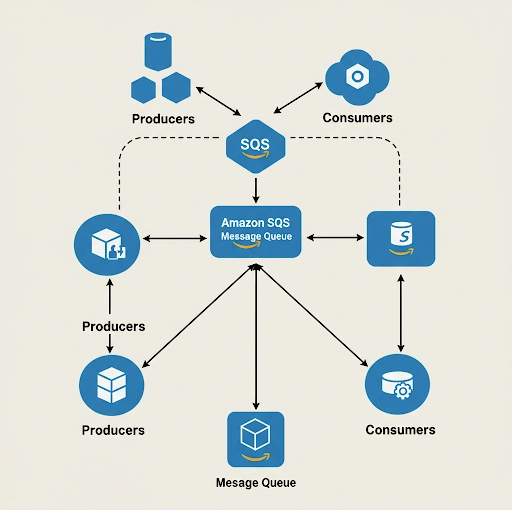Amazon Simple Queue Service (SQS)
Imagine you have different parts of an application that need to communicate, but you don't want them to be tightly connected or rely on each other being available at the exact same time. SQS acts like a highly reliable, scalable, and fully managed message mailbox (or queue) in the cloud. Here's the core idea: Producers: One part of your system (a producer) generates a piece of information (a message) it wants another part to handle. Instead of sending it directly, it places the message into an SQS queue. SQS Queue: SQS securely stores this message across multiple servers for durability. It holds the message until something comes to retrieve it. Think of it as a waiting area for tasks or data. Consumers: Another part of your system (a consumer) periodically checks the queue for new messages. When it finds one, it retrieves the message, processes the task or information contained within it, and then deletes the message from the queue to signal the work is done. Key Concepts and Benefits: Decoupling: SQS allows you to decouple the components of your application. The producer doesn't need to know anything about the consumer (how many there are, if they're busy, or even if they're running). It just needs to know how to send a message to the queue. Likewise, the consumer only needs to know how to poll the queue. This makes your system more resilient; if the consumer fails, messages just pile up safely in the queue until it (or another consumer) recovers. Asynchronous Processing: Producers can send messages and immediately move on to other tasks without waiting for the consumer to process them. This is great for background tasks like sending emails, resizing images, generating reports, etc. Scalability: SQS automatically scales to handle virtually any volume of messages without you needing to manage any infrastructure. You can have many producers and many consumers working with the same queue. Reliability: Messages are stored redundantly across multiple Availability Zones (AZs) within an AWS region. SQS ensures messages aren't lost. Load Leveling: If you have sudden bursts of requests (e.g., from a web application), SQS can act as a buffer. Producers dump messages into the queue quickly, and consumers can process them at a steady rate, preventing downstream systems from being overwhelmed. Fault Tolerance: If a consumer retrieves a message but fails before deleting it, SQS has a "visibility timeout" feature. After this timeout expires, the message becomes visible again in the queue for another consumer instance to pick up, ensuring the task eventually gets done. Fully Managed: AWS handles all the operational overhead: provisioning hardware, managing scaling, patching software, ensuring high availability. You just create a queue and start using it. Types of SQS Queues: Standard Queues (Default): Offer maximum throughput (nearly unlimited messages per second). Guarantee "at-least-once" delivery (a message is delivered at least once, but occasionally might be delivered more than once). Provide "best-effort" ordering (messages are generally delivered in the order sent, but it's not guaranteed). Suitable for most use cases where occasional duplicates or slight reordering isn't critical. FIFO (First-In, First-Out) Queues: Guarantee that messages are processed exactly once, in the exact order they are sent (within a specific message group). Have lower throughput limits compared to Standard queues. Used when the order of operations or avoiding duplicates is essential (e.g., financial transactions, commands in a sequence). Common Use Cases: Decoupling microservices. Distributing tasks for background processing. Buffering requests between web servers and backend systems. Sending notifications (email, SMS). Integrating serverless applications (e.g., triggering AWS Lambda functions). Workflow automation. In summary, Amazon SQS is a robust, scalable, and easy-to-use managed message queuing service that helps build loosely coupled, reliable, and scalable distributed systems in the cloud.

Imagine you have different parts of an application that need to communicate, but you don't want them to be tightly connected or rely on each other being available at the exact same time. SQS acts like a highly reliable, scalable, and fully managed message mailbox (or queue) in the cloud.
Here's the core idea:
Producers: One part of your system (a producer) generates a piece of information (a message) it wants another part to handle. Instead of sending it directly, it places the message into an SQS queue.
SQS Queue: SQS securely stores this message across multiple servers for durability. It holds the message until something comes to retrieve it. Think of it as a waiting area for tasks or data.
Consumers: Another part of your system (a consumer) periodically checks the queue for new messages. When it finds one, it retrieves the message, processes the task or information contained within it, and then deletes the message from the queue to signal the work is done.
Key Concepts and Benefits:
Decoupling: SQS allows you to decouple the components of your application. The producer doesn't need to know anything about the consumer (how many there are, if they're busy, or even if they're running). It just needs to know how to send a message to the queue. Likewise, the consumer only needs to know how to poll the queue. This makes your system more resilient; if the consumer fails, messages just pile up safely in the queue until it (or another consumer) recovers.
Asynchronous Processing: Producers can send messages and immediately move on to other tasks without waiting for the consumer to process them. This is great for background tasks like sending emails, resizing images, generating reports, etc.
Scalability: SQS automatically scales to handle virtually any volume of messages without you needing to manage any infrastructure. You can have many producers and many consumers working with the same queue.
Reliability: Messages are stored redundantly across multiple Availability Zones (AZs) within an AWS region. SQS ensures messages aren't lost.
Load Leveling: If you have sudden bursts of requests (e.g., from a web application), SQS can act as a buffer. Producers dump messages into the queue quickly, and consumers can process them at a steady rate, preventing downstream systems from being overwhelmed.
Fault Tolerance: If a consumer retrieves a message but fails before deleting it, SQS has a "visibility timeout" feature. After this timeout expires, the message becomes visible again in the queue for another consumer instance to pick up, ensuring the task eventually gets done.
Fully Managed: AWS handles all the operational overhead: provisioning hardware, managing scaling, patching software, ensuring high availability. You just create a queue and start using it.
Types of SQS Queues:
Standard Queues (Default):
Offer maximum throughput (nearly unlimited messages per second).
Guarantee "at-least-once" delivery (a message is delivered at least once, but occasionally might be delivered more than once).
Provide "best-effort" ordering (messages are generally delivered in the order sent, but it's not guaranteed).
Suitable for most use cases where occasional duplicates or slight reordering isn't critical.
FIFO (First-In, First-Out) Queues:
Guarantee that messages are processed exactly once, in the exact order they are sent (within a specific message group).
Have lower throughput limits compared to Standard queues.
Used when the order of operations or avoiding duplicates is essential (e.g., financial transactions, commands in a sequence).
Common Use Cases:
- Decoupling microservices.
- Distributing tasks for background processing.
- Buffering requests between web servers and backend systems.
- Sending notifications (email, SMS).
- Integrating serverless applications (e.g., triggering AWS Lambda functions).
- Workflow automation.
In summary, Amazon SQS is a robust, scalable, and easy-to-use managed message queuing service that helps build loosely coupled, reliable, and scalable distributed systems in the cloud.










































































































































































![[The AI Show Episode 144]: ChatGPT’s New Memory, Shopify CEO’s Leaked “AI First” Memo, Google Cloud Next Releases, o3 and o4-mini Coming Soon & Llama 4’s Rocky Launch](https://www.marketingaiinstitute.com/hubfs/ep%20144%20cover.png)


















































































































![[DEALS] The All-in-One Microsoft Office Pro 2019 for Windows: Lifetime License + Windows 11 Pro Bundle (89% off) & Other Deals Up To 98% Off](https://www.javacodegeeks.com/wp-content/uploads/2012/12/jcg-logo.jpg)





































![Is this too much for a modular monolith system? [closed]](https://i.sstatic.net/pYL1nsfg.png)






















































































































_Andreas_Prott_Alamy.jpg?width=1280&auto=webp&quality=80&disable=upscale#)
































































































![What features do you get with Gemini Advanced? [April 2025]](https://i0.wp.com/9to5google.com/wp-content/uploads/sites/4/2024/02/gemini-advanced-cover.jpg?resize=1200%2C628&quality=82&strip=all&ssl=1)













![Apple Shares Official Trailer for 'Long Way Home' Starring Ewan McGregor and Charley Boorman [Video]](https://www.iclarified.com/images/news/97069/97069/97069-640.jpg)
![Apple Watch Series 10 Back On Sale for $299! [Lowest Price Ever]](https://www.iclarified.com/images/news/96657/96657/96657-640.jpg)
![EU Postpones Apple App Store Fines Amid Tariff Negotiations [Report]](https://www.iclarified.com/images/news/97068/97068/97068-640.jpg)
![Apple Slips to Fifth in China's Smartphone Market with 9% Decline [Report]](https://www.iclarified.com/images/news/97065/97065/97065-640.jpg)




































































































































